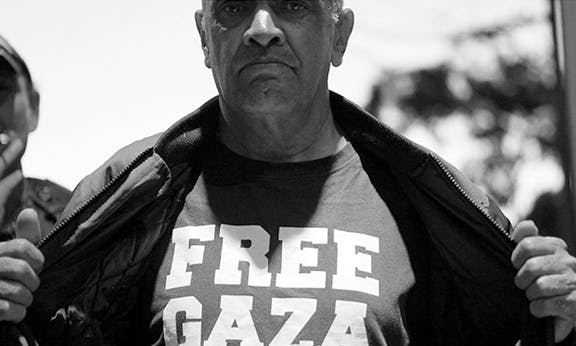Always will be

“It is my responsibility to bring our stories into the public domain, to hopefully connect and engage the audience with images through a black lens”, Barbara McGrady tells me at the opening of her photography exhibition “Always will be”. “Aboriginal and Torres Strait Islander history from a Black perspective is Australian history.”
McGrady’s work is joyful, tragic and inspiring. Her exhibition includes photos of Aboriginal people in sport, theatre, dance and protest. “I believe in the old adage ‘a picture tells a thousand words’”, she says. This may not be true of the hundreds of photos we glaze over on social media, but it is true of hers. Each image is stirring and intense. The photographs of Anthony Mundine are works of art, with every tendon and airborne drop of sweat in focus. The photographs of protests are varied, capturing people in the throes of passion or stealing a private moment of reflection.
Gary Foley, a veteran Aboriginal activist, historian and radical, flew to Sydney to open McGrady’s exhibition. He spoke of the way she brings an Aboriginal eye to history:
“It’s not just an Aboriginal eye, because there’s all sorts of Aboriginal eyes. If someone unfortunate like Noel Pearson was on the other end of the camera it wouldn’t be as good an exhibition as what you’ve got here. And that’s because Barbara represents an Aboriginal eye coming from a community perspective, from a grassroots perspective. She shows Black fellas in a positive way that is an important counter to all the racism and negativity coming from the Pauline Hansons and Donald Trumps out there.”
Anyone who has spent time on the Sydney left will know McGrady as an important fixture at demonstrations, taking snaps of people in protest, defiance and strength. She even brought her camera to the opening of her own exhibition because “that’s what I always do”. McGrady is more than a photographer. She is a historian and activist. Her photographs convey such power and such a range of emotions because she is not an impersonal documentarian but someone deeply invested in the struggles of her people and of the oppressed.
She has become a renowned sports photographer with a particular interest in boxing and rugby league. Many of her photographs have been published in major newspapers. But her grassroots perspective gives her sports photography such humanity and meaning. She is very passionate about sport and refuses to compartmentalise it away from broader politics:
“I have had a love of sport both as a player and spectator from a young age. There is a saying ‘sport transcends race’. Many believe that to be true. But in saying that, there is still the scourge of racism in sport as witnessed by the recent Adam Goodes racism saga, which I documented.”
One of the most impressive features of the exhibition is the many images of Aboriginal women playing rugby league. “They play with great skill and play just as hard and fast as the men and take pride in reppin’ their club, mob and country”, McGrady says.
One of the most moving photographs in the exhibition, one that alone is a reason for people to attend, is of TJ Hickey’s mother speaking at a protest on the 9th anniversary of her son’s murder. The annual protests that happen in Sydney on this anniversary are a testament to the strength of the Hickey family to fight injustice and to never let people forget the racist crime done to their son. McGrady feels this deeply:
“It is extremely sad and heartbreaking. I think I almost cried when I first saw it on my computer. As an Aboriginal mother of a son, I could relate to her grief and pain. I don’t know what it’s like to lose a young son in such horrific circumstances, but I have lost relatives who died in custody – as have most mob. When I asked Gail if it was ok to make the image public she said yes. I want people to know that’s how I feel all the time after the loss of TJ.”
That McGrady can bring this to light with artistry and obvious compassion is an important contribution to the ongoing struggle against police brutality towards Aboriginal people.
The exhibition displays many other photos of demonstrations. While they all are contemporary, this collection makes a clear historical link with the radical movement for Aboriginal self-determination in Sydney in the 1970s. McGrady began her career as an activist and a photographer in that period, and her work helps to keep alive a radicalism and an insistence on nothing short of full liberation – something that is absent from many mainstream Aboriginal cultural forums. The movements of today – Black Lives Matter, the Redfern Tent Embassy and the fight against deaths in custody – are made better for having a McGrady eye behind the lens.
McGrady’s exhibition is showing until 9 December at 72 Oxford Street, Darlinghurst.
https://acp.org.au/blogs/travelling-exhibitions/barbara-mcgrady-always-…
